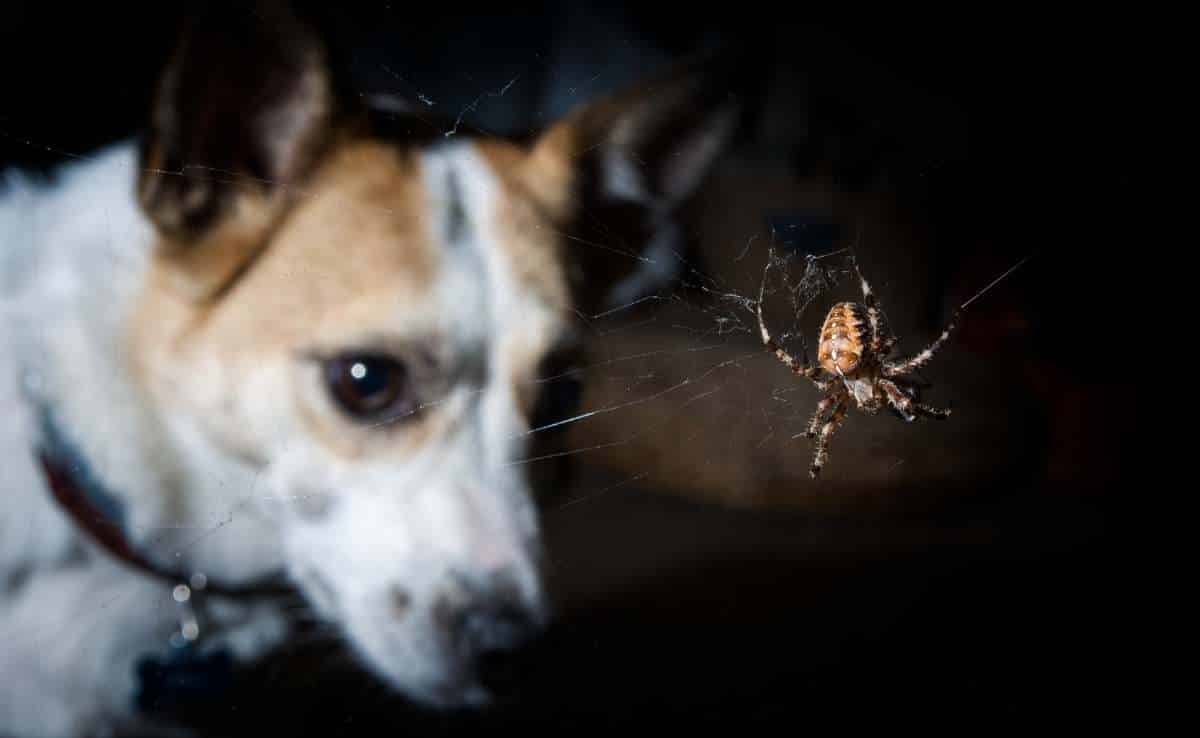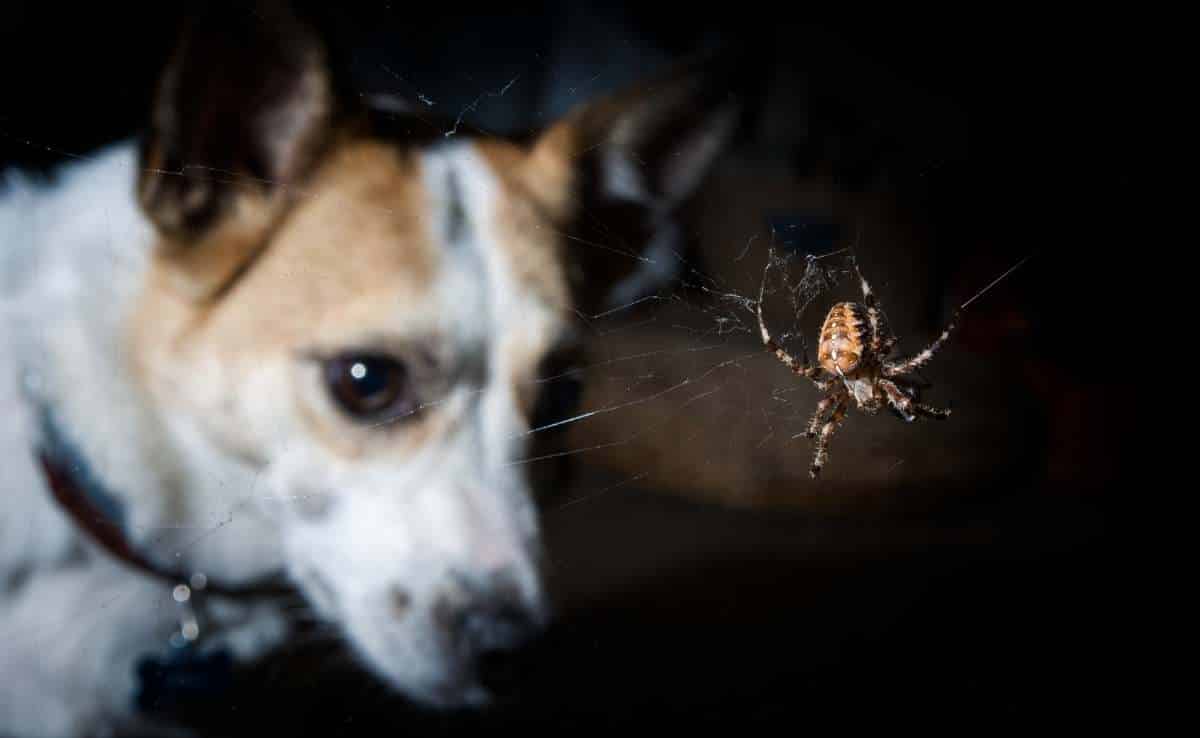
To keep the lights on, we receive affiliate commissions via some of our links. Our review process.
Our curious canine companions often don’t use caution when exploring their world. And this can lead to a web of trouble with some spider species in the United States. The good news is that most spider bites on dogs don’t pose a serious health threat unless a rare allergic reaction occurs. How do you know if a spider bit your pup? We’ll tell you the signs to watch for with mild to severe spider bites, home remedies to ease discomfort, when it’s time for immediate vet care, and much more.

Which Spiders Are Dangerous For Dogs?
Contents
Unfortunately, there are exceptions all spiders are dangerous. The most common dangerous spiders in the U.S. for pets (and humans) are the black widow (Latrodectus species) and brown recluse (Loxosceles species). Far less common are red and brown widow spiders. The venom delivered by a bite from these spiders can cause serious effects, which may require immediate veterinary attention.
Black Widow
Black widow spiders live throughout the U.S. but are more common in the South and West. Adult female black widows are about 38 millimeters long with their leg span and a 12-16 millimeter-long body. They’re shiny and black with a red or orange hourglass-shaped marking on the underside of their abdomen.
Males are about half the size of females, can be black or brown, and lack the hourglass marking. Only the females are toxic. Found in both urban and rural areas, black widows prefer to live in warm, dark, secluded places and are not aggressive.
Brown Recluse
Brown recluse spiders, also known as fiddleback or violin spiders, mainly live in the central Midwestern states and southward from Texas to western Georgia. They can also be found in the Southwest. The adult brown recluse spider’s body is about 3-8 millimeters long with a leg span of around 24 millimeters. Males are usually smaller than females, but both males and females are toxic.
They are various shades of brown, have a violin-shaped marking on their upper abdomen, and have fine hairs covering their bodies and legs. Like black widows, brown recluses aren’t aggressive and like to live in dark, undisturbed areas outside and indoors. But they’re more commonly found indoors than black widows.
What About Hobo And Wolf Spiders?
Unfortunately, there’s some outdated and false information you can find on the web about the toxicity of hobo and wolf spiders to pets. Hobo spiders, largely found in the Pacific Northwest, were once considered dangerous to humans and pets but are now believed to be non-toxic. The Centers for Disease Control (CDC) removed hobo spiders from their list of harmful venomous spiders in 2015.
Are wolf spiders poisonous to dogs? No. While you can find conflicting information on the web about various wolf spider species, they’re also considered non-toxic to dogs and humans. Still, although rare, some dogs suffer allergic reactions to spider bites, so keep an eye on your pup if you suspect he was bitten by a wolf, hobo, or another type of spider.
Spider Bite Symptoms In Dogs

What does a spider bite look like on a dog? Signs of a spider bite on a dog differ by the species of spider. However, most spider bites are entirely harmless and cause mild to no symptoms.
Signs Of Non-Toxic Spider Bites
It’s very difficult to distinguish most spider bites from insect bites unless you witnessed the culprit that caused the bite. Mild symptoms include:
- Small red bump
- Mild swelling and soreness
- Itching
- Licking the bite site
- Limping (if the bite is on the paw or leg)
Allergic Reactions
Allergic reactions to spider (and insect) bites can be mild, moderate, or severe. If your dog is experiencing these symptoms, you should call your vet. Breathing problems require immediate vet care.
- Redness and swelling at the site
- Hives
- Swollen face or muzzle
- Vomiting
- Difficulty breathing
Signs Of Black Widow Bites On Dogs
Female black widow venom contains α-Latrotoxin, a strong neurotoxin that affects the nervous system. Signs can present soon after the bite or take several hours to develop. Small, young, old, and immunocompromised dogs are at the highest risk for extremely severe symptoms. If your dog is exhibiting these signs, seek vet care immediately.
- Muscle pain and cramping
- Incoordination
- Tremors
- Drooling
- Vomiting and diarrhea
- Abdominal pain
- Muscle rigidity
- Increased heart rate and blood pressure
- Agitation
- Respiratory paralysis
- Death (rare in dogs)
Black widow bites typically are much more toxic and life-threatening for cats versus dogs. If you have a cat exhibiting these symptoms, emergency vet care is crucial to saving your cat’s life.
Signs Of Brown Recluse Bites On Dogs
A brown recluse’s venom is hemotoxic, meaning it destroys red blood cells and causes tissue damage and tissue death (necrosis) around the bite site. Symptoms can vary widely based on the amount of venom delivered and each dog’s sensitivity to the venom. Most bites cause localized tissue damage, but rare cases can cause liver and kidney damage.
- A blister at the bite site that sometimes develops into a bullseye shape
- Vomiting
- Fever
- Lethargy
- Bleeding/bruising (abnormal clotting)
- Skin turning purple around the bite (necrosis, or tissue death)
- A severe, deep skin wound can develop over time
- Liver and kidney damage (rare)
- Death (rare)
How To Treat A Spider Bite On A Dog
Treatment for spider bites on dogs depends on the type of spider. It can be challenging for veterinarians to diagnose a spider bite. The only certain diagnosis is if you catch and capture the offending arachnid and bring it to your vet. Therefore, diagnosis is usually based on clinical signs. Blood work can identify black widow venom in some cases but not always.
Home Remedies For Non-Toxic Bites

If your pup is experiencing discomfort from a non-toxic spider bite, insect bite, or bee sting without any concerning symptoms, you can treat the bite at home with the following home remedies.
- Wash the bite site with soap and water to help avoid infection.
- Apply a thick paste of baking soda and water or aloe vera gel to relieve itching.
- Use a cold compress for at least 10 minutes to reduce swelling and pain.
- Apply Sulfodene Dog Wound Care Ointment to help fight infection and relieve pain.
Symptoms should clear up in a few days, but keep an eye on your pup’s bite site. If it doesn’t clear up or symptoms worsen, you should call your vet.
Treatment For Black Widow Bites
Fortunately, antivenom treatment is available to combat severe symptoms of black widow bites (for both dogs and cats). Your vet may hospitalize your dog, and administer antivenom, which requires an IV fluid drip. This antivenom can have allergic side effects for some dogs, so your vet will monitor his reaction.
Other treatments can include muscle relaxants, antiseizure medications, pain medications, and any other necessary supportive care. Most dogs have a good prognosis with prompt treatment, although full recovery can take a few months.
Treatment For Brown Recluse Bites
There is no antivenom for brown recluse bites, so treatment usually involves wound care: thoroughly cleaning the wound, applying a cold compress, and bandaging. Seeking vet care is important early on before symptoms worsen. Your vet will recommend regular wound care and may prescribe antibiotics to avoid infection. Most bites will heal within several weeks without complications, but your vet likely will want to check the wound site at least once a week to make sure it’s healing properly.
If your dog is experiencing severe systemic symptoms, IV fluids and hospitalization may be required (although this is rare). And if there’s been significant cell and tissue damage, your dog may need surgical treatment to remove the dead tissue and eventually skin grafting once the lesion stops spreading.
Prevention
If you’re concerned about your dog or your family members being bitten by a toxic spider, you may want to help spider-proof your home and follow safety measures by:
- Keeping your pup away from woodpiles
- Restricting your dog from attics, basements, and closets
- Trimming the vegetation outside your home
- Sealing cracks and holes on your home’s exterior
- Removing debris and clutter around your home
- Spraying a pet-friendly spider repellant in holes and cracks around your home
- Hiring a professional spider exterminator
For more tips on how to control spiders in your house and outdoors, check out this brief video from The Home Depot.
How Can Pet Insurance Help With Emergencies?
Although toxic spider bites are fairly rare, many other costly health emergencies or illnesses can occur anytime with your dog. You may want to consider getting pet insurance as a proactive measure to lower your financial risk for potential health threats during your dog’s lifetime.
A reasonable monthly premium for a pet insurance policy can cover a portion of your vet expenses for emergencies, accidents, and unforeseen illnesses. You never want to face the decision of sacrificing your dog’s health and wellbeing because you can’t afford treatment. Check out our comprehensive pet insurance guide to see if it’s a worthy investment for your family.
Tagged With: